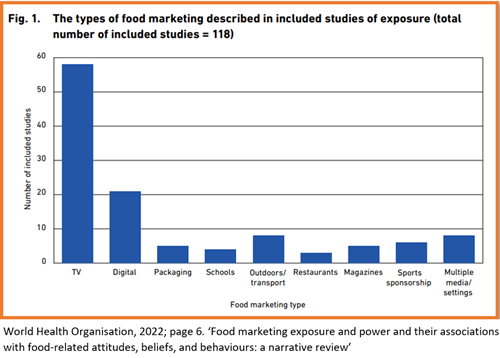ill ad-vised: a review of food marketing power
08 March 2022
When you think of an advert relating to food, what comes to mind? Is it a TV advert promoting ingredients to make a healthy pasta dish? Or a billboard ad encouraging children to try more vegetables? Unfortunately, very different examples are far more familiar to us. The modern food environment is flooded with adverts and promotions for foods and brands which damage our health. The power of the marketing mix – expertly described in the 2021 Turning the Tide report – has been pitted against entire populations in order to encourage and manipulate us into eating poor quality foods which are designed to keep us coming back for more. On top of this, a large proportion of this marketing power is purposefully directed towards children and young people in the knowledge that they are more impressionable and therefore more likely to be influenced by advertising activity.
2022 WHO Report on Food Marketing Power
In February, The World Health Organisation published a narrative review of recent literature examining food marketing, its power, and its impacts on children. Using a specific article selection process, 118 studies published globally since 2009 were identified to be included in the review in order to give a thorough summary of the most recent evidence in the area of food marketing. Studies were categorised by whether they looked at food marketing exposure (how people come in to contact with adverts, figure 1) and food marketing power (the actual content of adverts).
The review revealed some shocking findings in regards to studies dealing with exposure of children to unhealthy food marketing, with the majority of studies reporting that over 50% of food marketing involved unhealthy products. In fact, some studies showed that the marketing skew towards unhealthy products was as high as 90%. Sugar-sweetened beverages, confectionary, and fast food were the three most common types of unhealthy food groups when combining the findings of all exposure studies (figure 2). Also, multiple studies showed TV advertising for unhealthy products was more frequent during children’s typical viewing times, highlighting the blatant targeting of young people.

Studies dealing with the power of food marketing pointed to other concerning findings. A variety of tactics used to attract children were listed in the review, with the most common across the studies including the use of promotional characters, gifts and incentives, persuasive ‘fun’ themes, and health claims. Several studies showed such tactics are used more often to promote unhealthy products as opposed to healthy ones to young people. Arguably one of the most significant findings of multiple studies in the review was the positive association found between exposure to adverts and higher consumption of the advertised foods.
Other important results from the studies included that children were often easily able to recognise unhealthy food brands, and that food marketing which used engagement via social media was associated with greater consumption impacts than standard media channels. Furthermore, a recurring theme throughout studies was concern, both from parents and children, around the appropriateness and honesty of food marketing.

It should be noted that many findings in the review were based on associations as opposed to causal links. We know that advertising is only one of many factors (e.g. socioeconomic position, learned shopping habits) at play in food choice decisions. Significantly, the majority of studies found evidence that food marketing is skewed towards unhealthy products and it uses specific tactics to target children which influences food preferences and consumption behaviours.
Time for Urgent Action
It is clear from the evidence that the marketing used in our food environment does not support us to make healthy food choices and instead pushes us in the opposite direction. This is an area that is now receiving more attention from policymakers, with new proposals including the UK government Health and Care Bill which includes planned restrictions on TV adverts and paid-for online advertising. However, the evidence from the WHO report underlines the breadth and depth of food marketing tactics, of which TV and paid online ads are just a couple of avenues. It is vital that marketing of unhealthy foods is tackled further in digital environments such as social media platforms, as well as outdoor settings and in print media. Tactics which are used to specifically target children should be a priority in order to protect the health of young people and their future. Although not a silver bullet, restrictions on marketing are an essential element of improving the food environment and we are starting to see evidence of how they can be effective at improving people’s food choices.
The results provided by this latest WHO report further strengthen the evidence base and should be a wake-up call to governments around the world, including policymakers in Scotland. The fact that parents and children alike show concern for the current state of food marketing is a crucial factor which governments have a duty to address. Policies which stand up to the relentless marketing of unhealthy foods are urgently needed to give people in Scotland a better chance of living healthier lives.
Read the full WHO review here
